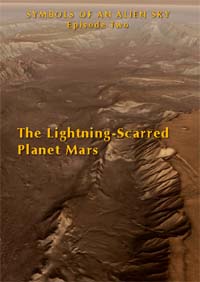|

Previously considered (blue) and
current mission landing sites.
Credit: ESA/DLR/FU Berlin (G. Neukum)
Phobos-Grunt
Feb
09, 2011
A Russian space mission will
attempt to land a sample return
package on Phobos.
In October 2011 the Russian Space
agency,
RosCosmos, will launch a
scientific instrument package toward
Mars, with a planned landing on its
largest moon in either March or
April of 2013. The small lander will
gather samples of the surface and
then blast off for a rendezvous with
an Earth return vehicle.
Phobos and
Deimos are the two moons
of Mars, although Deimos is so small
it cannot be readily observed from
Earth. Only the Viking 2 orbiter
captured close up images in 1976.
Phobos has been
extensively studied by Earth-based
telescopes and by satellites in Mars
orbit.
Picture of the Day articles about
Mars have shown that it was once
immersed in a plasma flame
sufficiently large to gouge out
Valles Marineris.
Millions of cubic kilometers of rock
and dust were blasted out from the
planet at escape velocity. Stone
blocks larger than Manhattan Island
fell back to Mars from a great
height, shattering on impact. This
explains the fields of enormous
boulders with sharp edges covering
millions of square kilometers. Could
it be that moons like Phobos and
Deimos, as well as asteroids like
Ida, were also born from that
cataclysm?
Stickney crater dominates one
hemisphere of Phobos. It is 10
kilometers wide and more than 100
meters deep. Many previous Picture
of the Day articles mention the
physical problems associated with
blasting large craters into small
bodies. For example, there is a hole
in asteroid
253 Mathilde that should
have caused it to disintegrate.
Phobos is a mere 28 by 20 kilometers
in size, so Stickney is nearly half
as big.
Scientists speculate that
asteroids (and perhaps small moons)
are loose aggregations of rocks and
soil, similar to a gravel pit in
space. Since they were not blown
apart from meteor impacts, it is
thought that they most likely
behaved like a pile of sand,
cushioning the shock. Does the
gravel pile theory best fit the
facts?
Since Phobos is about the same
size as asteroids
Mathilde,
Eros and
Ida, exhibiting the same
features like
relatively gigantic craters,
is there a common event that can
form similar structures without
obliterating the objects in the
first place? The answer is
electricity.
The electrical history of the
solar system includes intensely
energetic events and violent
interactions between charged planets
and moons. That electric arcs can
remove material with ease is proven
by the experiments conducted by Dr.
C. J. Ransom of VEMASAT
Laboratories. His plasma discharges
excavate surface depressions, scoop
out material, and explode it into
the air, leaving cleanly cut
features.
The lightning bolts that carved
Mars threw large chunks of its crust
into orbit around it, as well as
sending them around the Sun. The
electric fields that accompanied the
celestial disasters of the past
smoothed and eroded them with plasma
discharges. The result is that
Phobos and the asteroids mentioned
are covered in dust, are defined by
huge craters, and look like they're
half-melted.
Phobos and Deimos appear to be
remnants of a catastrophic event
that electrically devastated their
parent planet.
Stephen Smith
Multimedia

The Lightning-Scarred Planet Mars
Symbols of an Alien Sky
DVD episode 2
A video documentary that could change everything you thought you knew
about ancient times and symbols.
The Symbols of an Alien Sky video series will introduce you to celestial
spectacles and earth-shaking events once remembered around the world.
Archaic symbols of these events still surround us, some as icons of the
world’s great religions, though the origins of the symbols appear to be
lost in
obscurity.
In this second episode of Symbols of an Alien Sky, David
Talbott takes the viewer on an odyssey across the surface of Mars.
Exploring feature after feature of the planet, he finds that only
electric arcs could produce the observed patterns. The high resolution
images reveal massive channels and gouges, great mounds, and crater
chains, none finding an explanation in traditional geology, but all
matching the scars from electric discharge experiments in the
laboratory.
(Approximately 85 minutes) See:
Lightning-Scarred
Planet info
|








